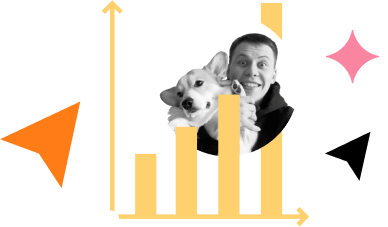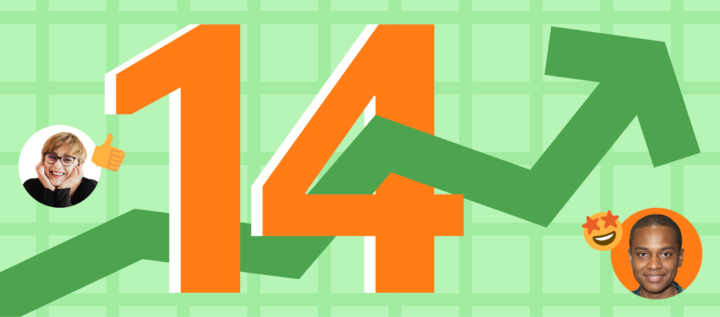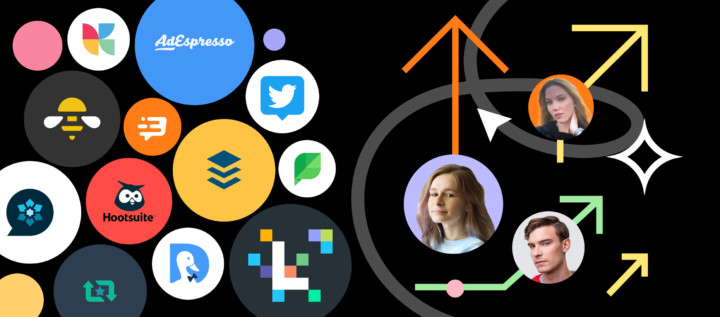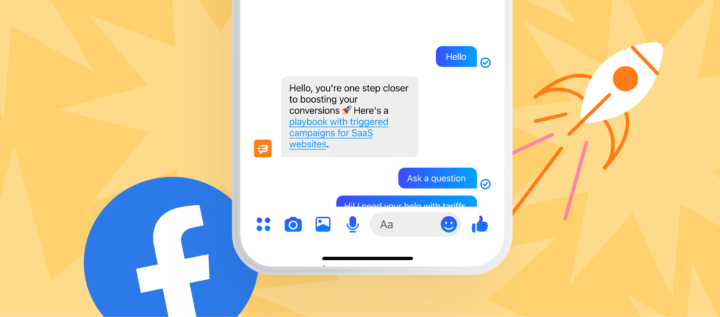PLG Product Led Growth Marketing: a step-by-step guide to hacking product growth
Discover the secrets of rapid business growth from a growth marketing expert. What people to hire, how to manage a team, launch experiments, what tools to use, and a list of proven examples to inspire you.
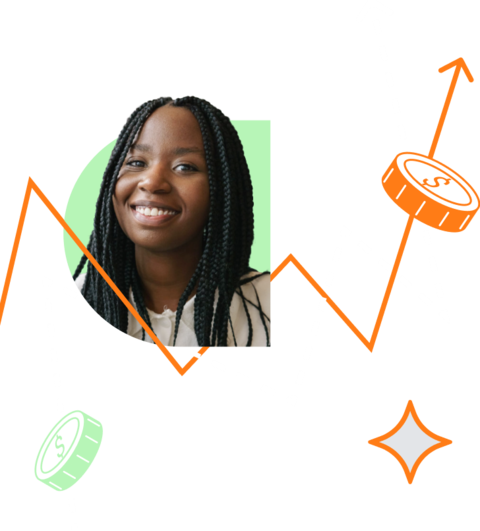
Part 1: Guide to growth marketing explained by a growth hacker
Part 3: Guide to hacking your product led growth
Part 4: 3 rules and 5 must-have roles when building growth marketing team
Part 5: How to produce growth hypotheses
Part 6: Your growth marketing strategy template, guide, and examples
Part 10: A secret collection of growth marketing tools
Part 12: 25 Growth Marketing Books
In this article, we have collected an extract from the article by Mark Roberge, Managing Director of Stage 2 Capital, former CRO (Chief Revenue Officer) of HubSpot, and a professor at Harvard Business School, and our own experience.
Mark teaches the course ‘Secrets of Silicon Valley Growth’ at Harvard. The goal of the course is to understand how product-led growth works. After the course, Mark compiled his observations on Product-led Growth (PLG) into this step-by-step guide.
The article contains the following:
- a clear and logical algorithm for working on product-led growth strategy,
- practical tips for accelerating your business performance,
- a deep understanding of the connected work and communication problems on the path to PLG. We have faced some of these problems on our way and would have been glad to read this article earlier to avoid them.
That’s why we shared the shortened guide version and our PLG experience at Dashly. We follow some of the tips from this article to a T, adapt the others to the Dashly specifics, and are currently reshaping the rest, following Mark’s recommendations.
But first, let’s figure out the PLG meaning.
Product-led Growth is a business methodology in which user acquisition and retention depend primarily on the product. Following this approach, a company understands that the product is the most significant sustainable and scalable business development source.
Define and follow four North Star metrics
When it comes to product-led growth strategy, there are two interesting observations regarding the metrics:
- Focus on one metric, aka the company’s North Star metric.
- The North Star metric evolves together with your company.
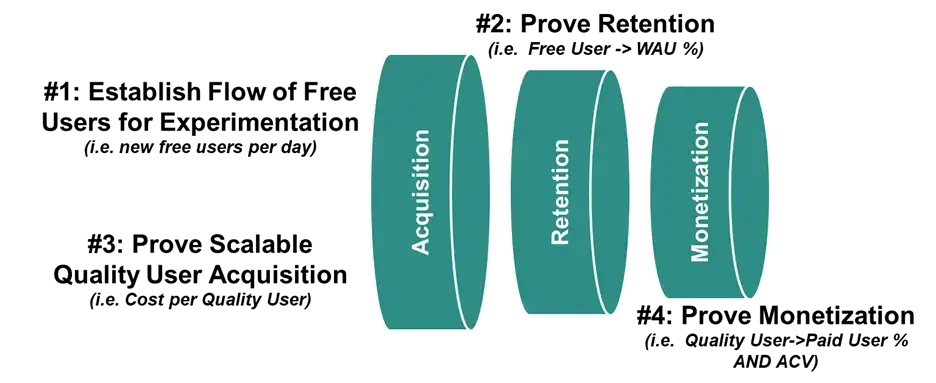
North Star Metric #1: Gain new product users at the top of the funnel for growth experiments
When you have just started working on growth marketing, make sure you have a lot of new users for experimentation, learning, and optimization. The more, the better. A more significant user flow facilitates faster learning.
To quickly acquire the desired user base, paid channels are optimal. It’s up to you to focus on user acquisition or monetization. Your goal here is to acquire as many users as possible for experimentation.
So, lead growth is the first step in your product-led market map.
Read also: 25 Growth Marketing Books to Skyrocket Success
North Star Metric #2: Prove the product value through retention metrics
After establishing the process of attracting users, evaluate if your product delivers the promised value. There are two ways to find out, and Mark Roberge recommends PLG startups use both.
The first approach was proposed by Brian Belfour
He proposes calculating user retention by cohorts based on the acquisition date. Begin by defining a user retention metric (e.g., DAUs/WAUs/MAUs) or use a metric tailored to your product. This LinkedIn article covers choosing the ‘Quality Registration’ metric as a benchmark. It can be calculated instantly and is highly correlated with long-term user retention.
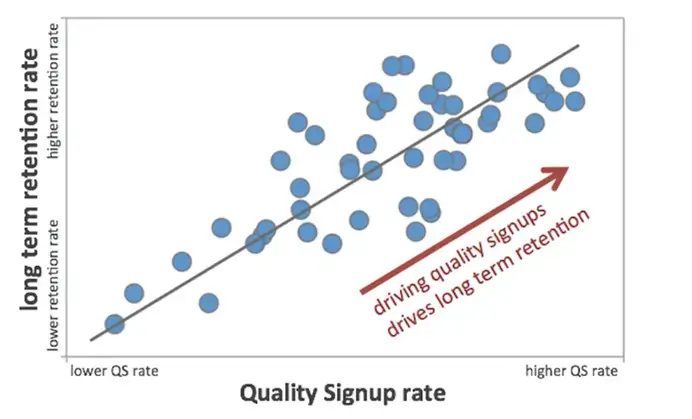
Belfour’s approach displays user retention in a chart, dividing users into cohorts based on the acquisition period. When user retention drops off, growth flattens.
If retention remains sufficient over time, as shown in the graph on the right, the product will grow. Your PLG business can move on to the third step only when your graph looks like the one on the right.
The second way to assess the product’s usefulness, proposed by Sean Ellis, is to collect customer feedback via interviews.
He suggests asking them a simple question, “How would you feel if you could no longer use our product?” and offering three answer options:
- “Not upset,”
- “Somewhat upset,”
- and “Very upset.”
Ellis considers it a good result when more than 40% of users answer that they would be “Very upset.”
When using both methods, it is crucial to segment users. The goal is not to maintain retention at a stable level or to obtain 40% of firmly attached users to the product. Instead, a product-led company aims to keep a large segment of the user base in the product. This segment used to be “quality users.” In contrast, B2B companies in the IT sphere call it the Ideal Customer Profile (ICP).
18 business growth experts you should follow this year
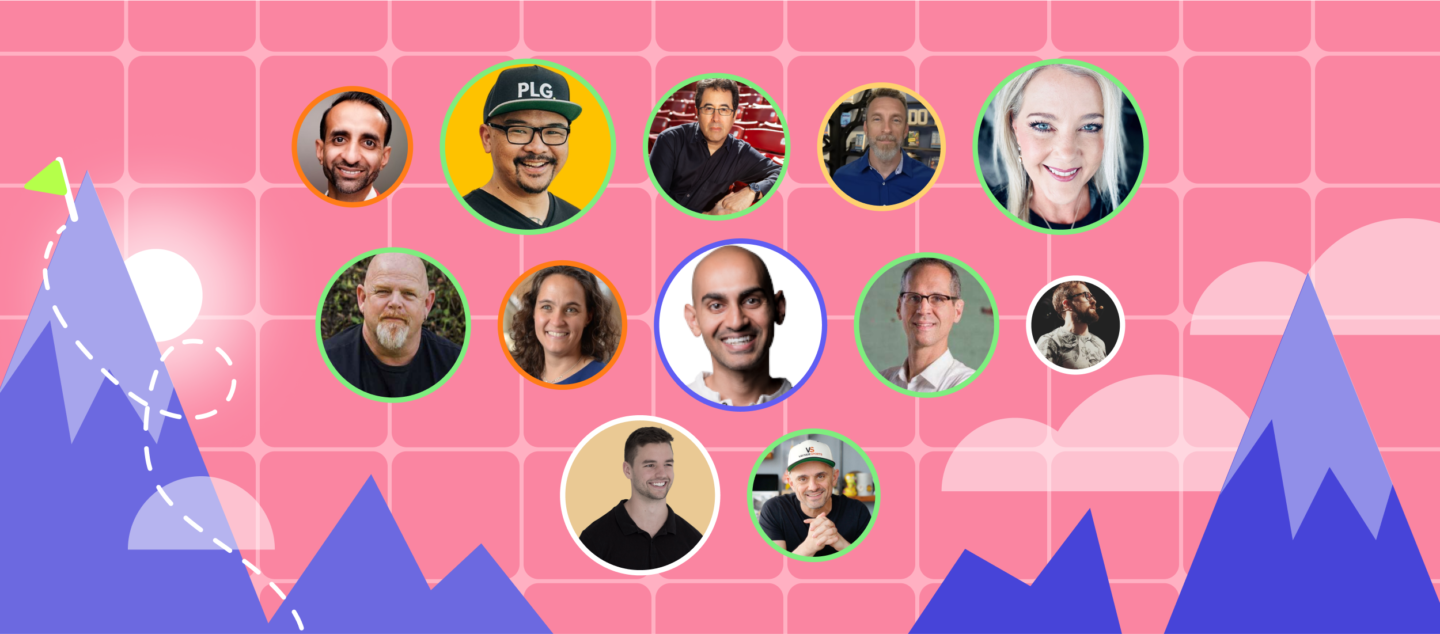
What are Growth Loops? How It Can Scale Your Company
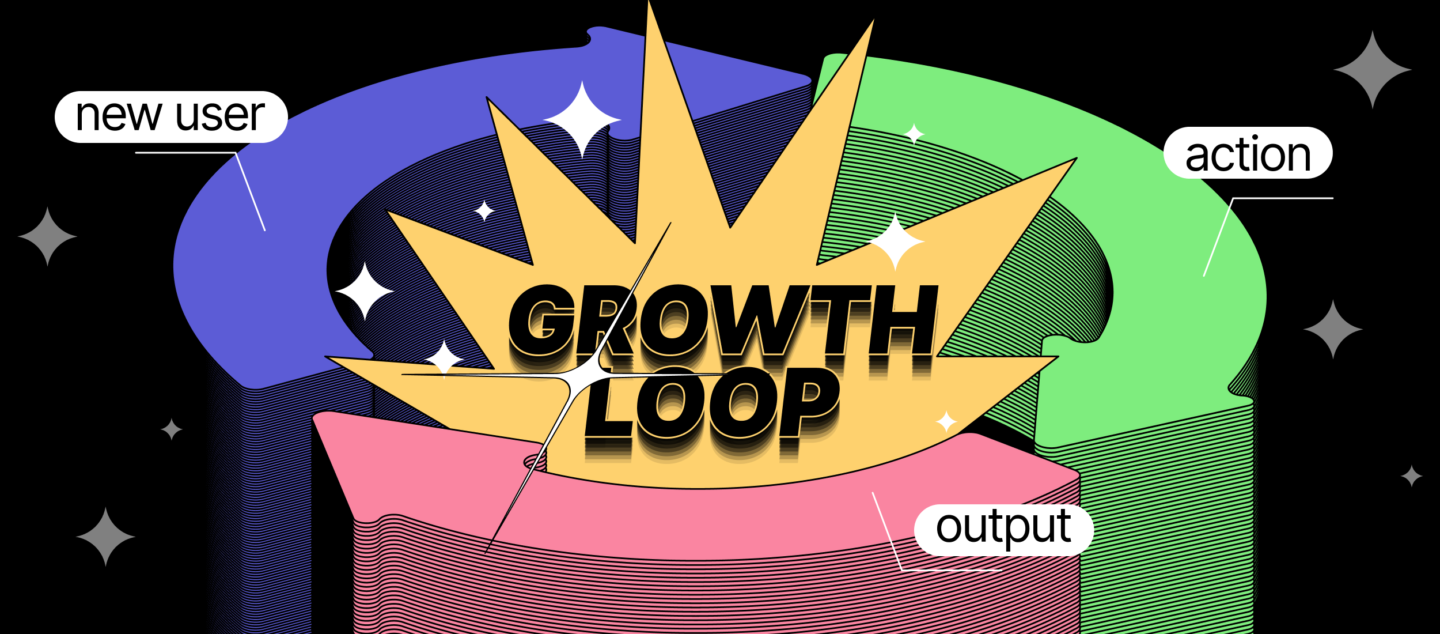
A Comprehensive Guide to Customer Led Growth (CLG)

How Dashly Works 👇
At the end of 2021, we at Dashly conducted a Sean Ellis-style survey. Our product manager and head of product launched it in our service. Also, they called some users to interview over the phone. As a result, we received 200 responses and were able to evaluate our Product-Market Fit — how well our product meets market expectations.
We also found that users who would be upset if Dashly no longer existed worked in different types of businesses, such as SaaS and eCommerce. We then began to study how satisfied representatives of each of these groups are with our service and what features they use.
The interview became the starting point for a new iteration of Jobs to be Done research. We interviewed our most loyal users and determined what jobs they perform using our product.
As a result, we better understood our target audience’s pain points. We considered these ideas when creating a product roadmap for hacking business development.
Thanks! Here’s your copy of 100 growth ideas
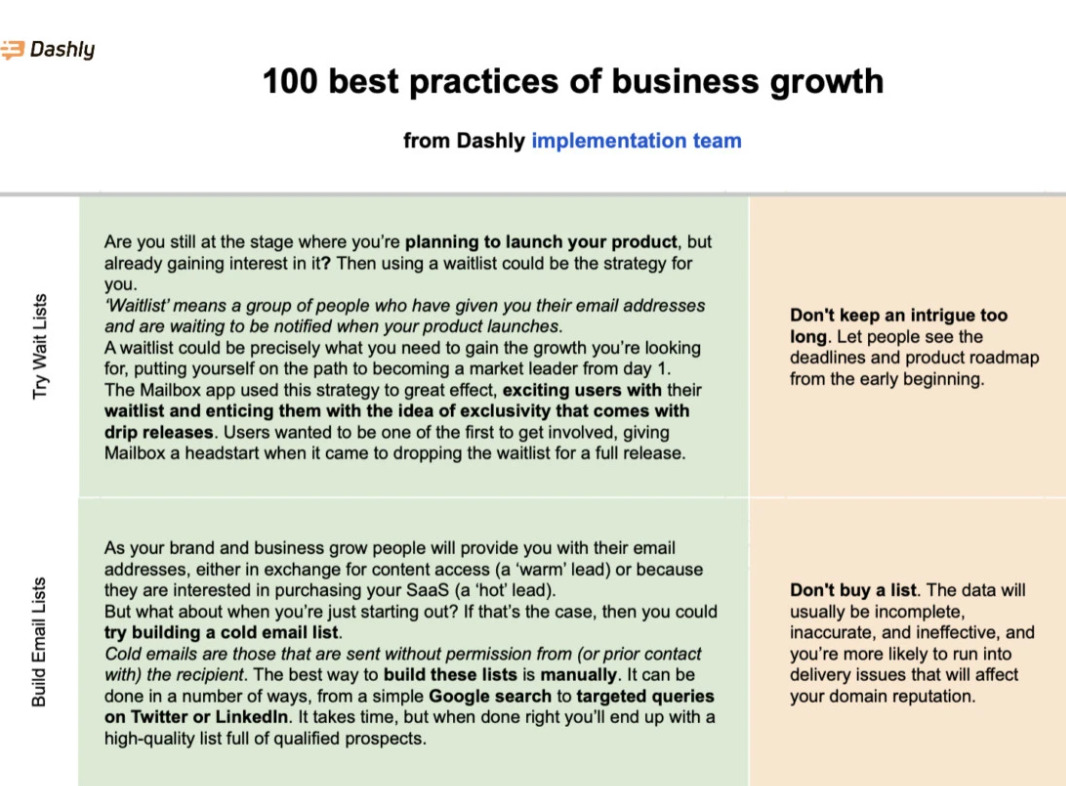
North Star Metric #3: Scale the acquisition of quality product users
After identifying the audience segment for your product, find a scalable acquisition channel with quality users at an acceptable CAC.
To calculate a reasonable acquisition cost for your PLG, estimate the conversion rates of paid channels and the user revenue per year (ACV) you can achieve.
At this stage, product led companies strive to find budget-friendly channels, often choosing virality and content as their primary acquisition methods. Cold calling and paid promotion require large budgets, so they are rarely used at this stage.
North Star Metric #4: Prove product monetization opportunity
You identified the “quality users” and the acquisition channel. Now focus on turning free trial users into paid ones.
How Dashly Works 👇
At Dashly, the growth department was formed a few years after the product creation. During that time, we had already learned how to:
- attract users to the free trial version of the product,
- retain them,
- and monetize the service.
Read also: Growth marketing vs performance marketing.
However, we faced a challenge: we wanted to grow by five times annually, but we only achieved a 1.5 times increase. Therefore, we needed to scale user acquisition.
Previously, our primary sources of the acquisition were content and virality. We realized that we could attract more new users by mastering paid channels. We tested various channels, dozens of offers, and creatives to find the best combination.
Throughout this time, we stuck to the PLG business model and kept in mind our North Star metric — the cost of one demo conducted for a customer. This is Mark Robberge’s North Star metric from the list.
If you want to master the hypothesis generation, check out this article:
Create a cross-functional team that reports to the product
It should include cross-functional specialists:
- Product managers gather information from various sources and prioritize experiments.
- Full-stack developers dedicate some of their time to experiments that require coding. The rest of the time is for developing tools that allow “non-technical” specialists to conduct experiments independently.
- Designers are responsible for the UI and UX of the product. They develop advertising creatives, landing pages, in-app messages, and other UI/UX elements for experiments.
- Analysts collect and interpret growth marketing analytics data, influencing product strategy and roadmap.
- Marketers conduct experiments to attract users, mainly through email channels, paid advertising, and viral management, and test various growth marketing tools.
- Support managers act as the first support line in a live chat on the site and email. CS managers interact with users stuck at different funnel stages and tell others about user behavior patterns.
Most B2B startups striving for the PLG model separate their marketers and product people. This is wrong. Fragmented structure leads to local maxima, e.g.,
- marketers strive to attract users,
- product people wantsto retain them.
Cross-functional growth marketing team, on the other hand, have a common goal: attracting/retaining quality customers.
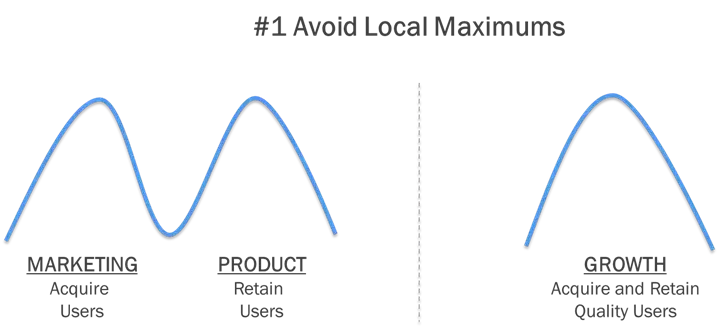
A fragmented structure splits responsibilities between marketing (acquisition and monetization) and product (retention) departments, but both can influence others’ tasks. Alignment leads to optimal resource allocation & North Star metric improvement.
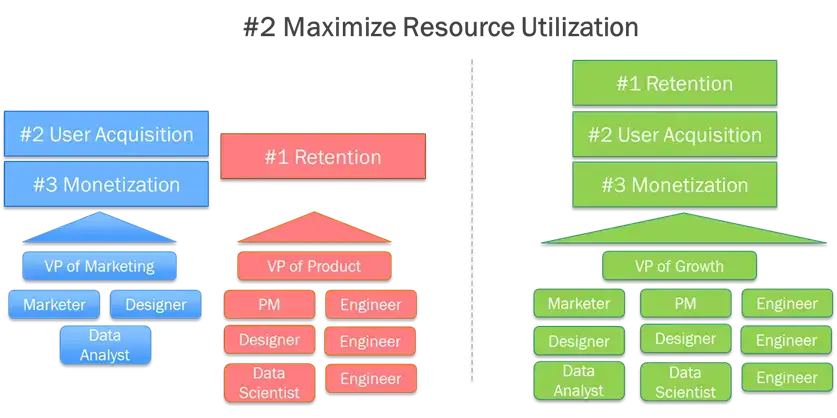
As a product grows, employees should become more specialized
In the early stages of a company’s development, this department typically consists of 2-3 specialists with multi-faceted skills, e.g., developers with design expertise or product managers with PPC know-how. As the company develops, product-led hackers focus on specific functions, buyer personas, and features.
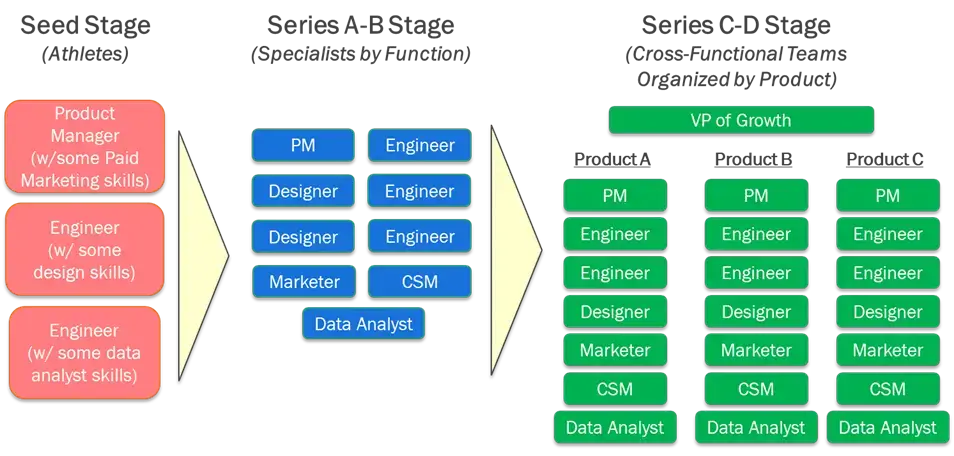
Split the development into those working with the product and the growth people
The fastest-growing PLG companies divide developers into a Core department responsible for product development and developers working to improve the funnel. It allows better resource allocation beyond the product roadmap i.e. relieving bottlenecks.
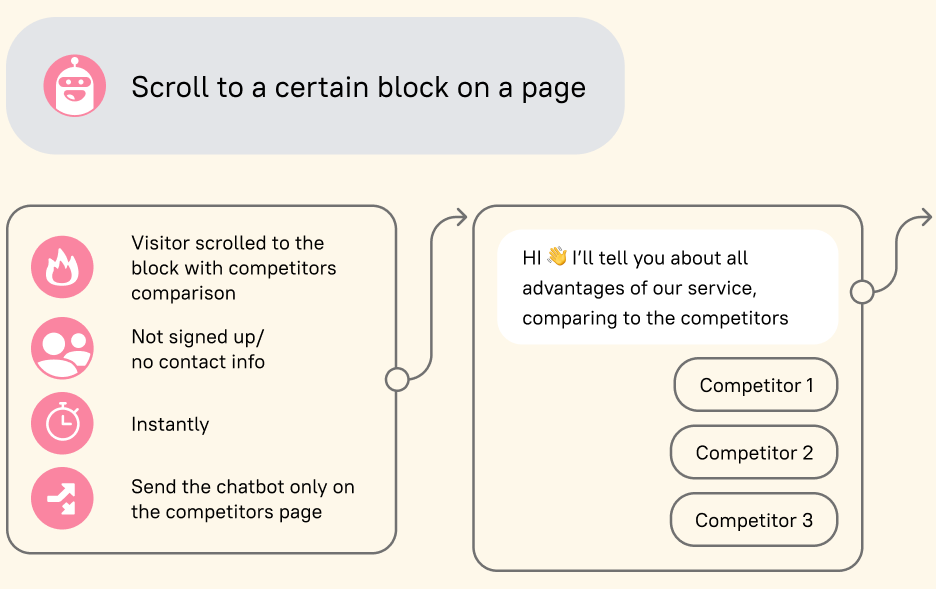
Get your free example of growth marketing playbook with 40+ templates for successful experiments
Product-led growth managers should report to the product, not the marketing
Now, let’s look at product-led growth vs. marketing led growth.
- In the product-led growth companies we studied, growth-managers reported to the product. Departments that suffered from growth blockages reported to marketing. Here’s a hypothesis about the reasons for such regularity.
- As part of marketing, the growth department disincentivizes developers from helping with experiments. Thus, marketers must ask product people to allocate resources when testing hypotheses.
In most IT companies, the product department has more power, so marketing cannot get resources and limits experiments at the top of the funnel, which they can influence.
Thus, the streamlined work of other departments with the product is one of the most valuable growth-marketing tips.
Include the growth team in the product structure and give them access to marketing resources
How it works in Dashly 👇
Our grow hackers were born within marketing. Again, this was related to our North Star metric — to attract more end users sales. In addition, it was much easier to conduct experiments at the top of the funnel. We could quickly achieve statistically significant results.
In contrast, experiments inside the product required much more time and resources.
For some time, this way worked great. We collected consumer experience information and data from:
- sales team calls,
- client interviews,
- and market analysis.
And we quickly launched experiments using various no-code tools:
- landing page builders,
- quizzes,
- and email campaigns.
Thanks! Here’s your copy of 50 growth hacking tools
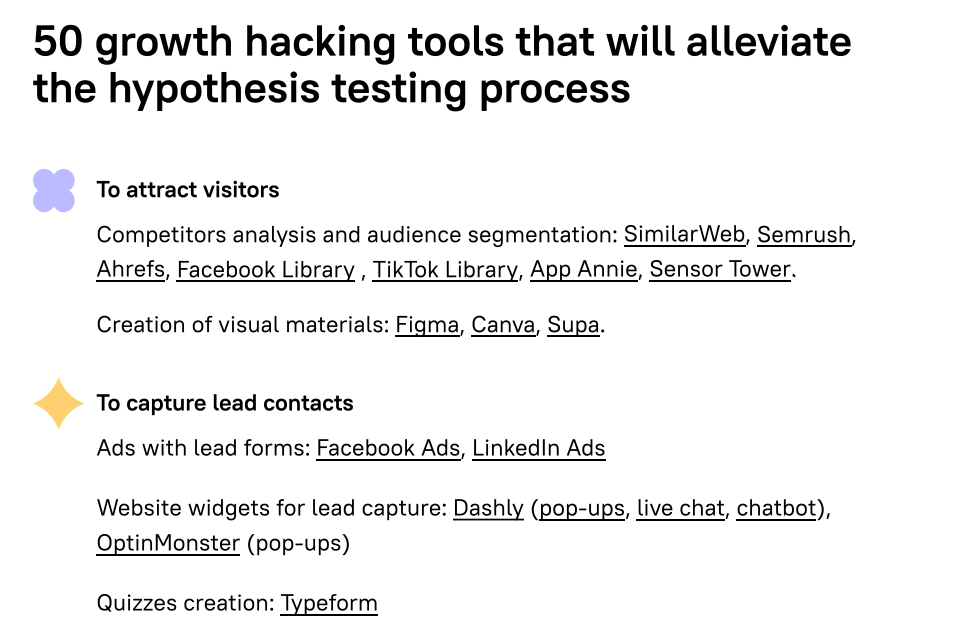
About 7 months after starting work, we realized a need for more resources and synchronization with the product people. The growth department receives a lot of inspiration about customer experience during experiments:
- which product features help attract users and which do not;
- what our target audience wants;
- what repels them from the product.
However, it took a lot of work for us to convey insights to the product department. Unfortunately, they could not implement it due to an overloaded roadmap and sprints. So now we are actually rethinking the growth-managers’ tasks based on this article’s recommendations.
We at Dashly want to help you build a compelling growth department. So here are a few tips based on our own experience:
Change the way customers communicate with your brand from sales to support
Customers initially meet sales managers. However, they rush to qualify and close the deal. So according to the PLG strategy, a support manager should introduce the product, as they understand how to help users best utilize it.
Encourage sales managers to check existing customers instead of attracting new
Now, let’s consider PLG in sales. Customers prefer to learn about the product themselves. Once they see that the product solves their problem, they can bring other departments from their company into it.
The traditional reward model for bringing new customers forces sales managers to convince users to implement the product throughout the company.
The goals of the sales manager and the client conflict with each other. If the manager sells the whole package, the client pays for functions that are not used, and they do not see any benefit from it. Thus, a customer who could bring more end users from their company to the product reduces the check or even leaves.
Encouraging sales managers to increase the average bill allows them to connect the goals of the client and the sales manager and not kill the power of PLG.
How Dashly works 👇
Dashly has two funnels: self-service and high-touch.
- In the self-service model, the user gets familiar with the product and uses it independently.
- In the high-touch funnel, our sales managers introduce customers to the product and offer expert assistance.
Within this assistance, a department consisting of a personal manager, designer, analyst, and developer is assigned. The manager analyzes the customer’s funnel and, together with the team, tests trigger scenarios to increase conversion.
Read also: Your Growth Marketing Strategy Template with guide and examples
Both funnels start the same way:
- The user registers with Dashly to test it.
- We provide a free trial period that allows the customer to determine if the product fits their needs before purchasing a subscription.
The sales manager can conduct a product demo during the free trial period. It follows specific rules:
- We hold a meeting only after studying the client’s business, understanding their tasks and pain points;
- We focus on how the product can meet the customer needs;
- We adhere to the “Adopt-Before-Buy” concept — when the customer first tests the product, understands its value, and only then purchases it.
Establish quick and high-quality hypothesis testing
The best growth teams test multiple product-led hypotheses daily. Conducting experiments and implementing successful practices comprise a significant part of the team’s work within PLG principles. It can be challenging for a B2B startup to put experiments on stream, but you should strive to test at least 2-3 hypotheses weekly. Here are a few tips that will help you conduct quality experiments:
Plan the experiment. Here is an example of a well-planned experiment:
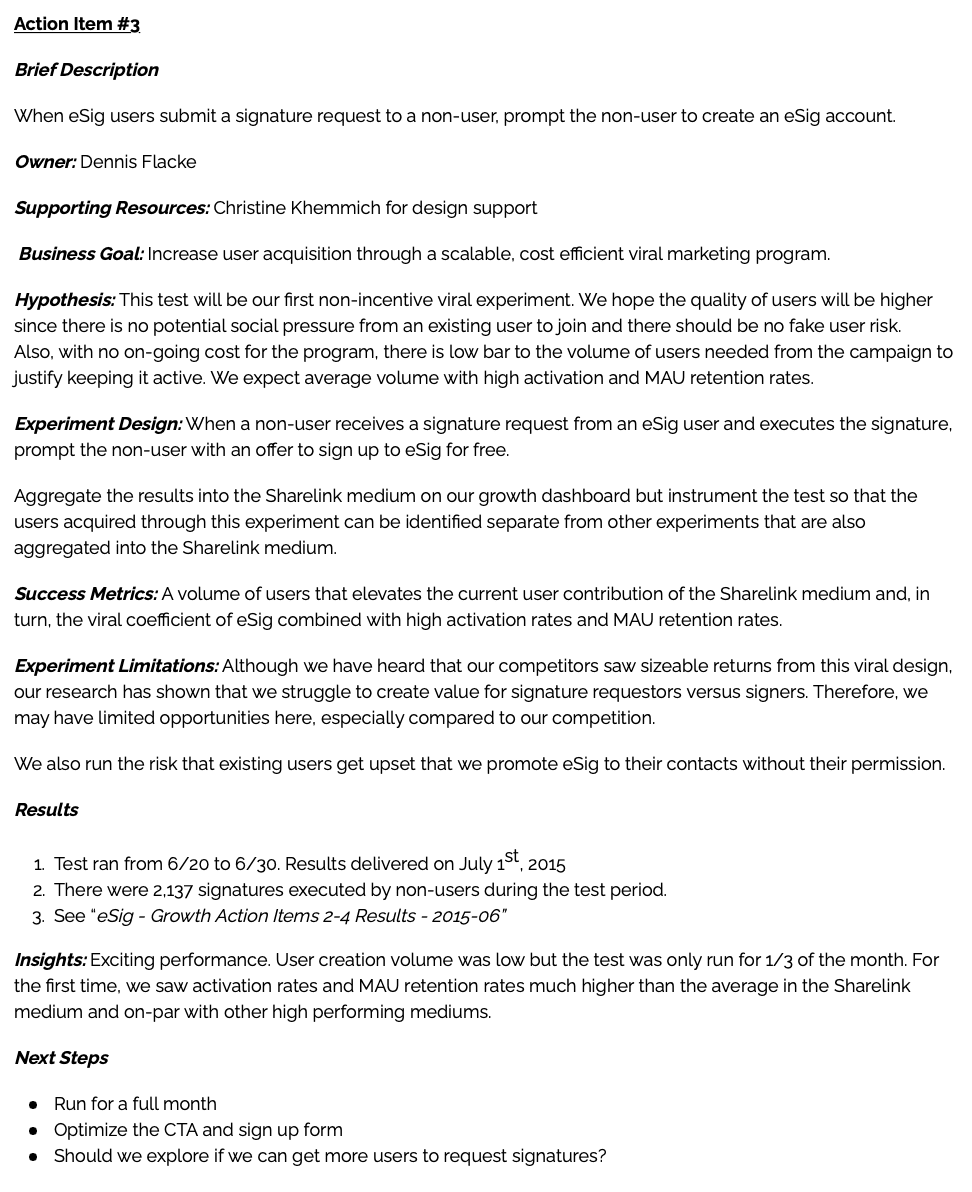
Plan weekly meetings
Discuss PLG experiments from the previous week, their results, insights, and ideas for the following experiments. Btw, you can find even more experiment ideas in our growth-marketing playbook.
John Egan from Pinterest recommends the “bottom-up” idea generation model. Following the PLG strategy, startups can encourage all employees to contribute during the idea-generation stage. Different teams have different experiences interacting with customers, which helps get more ideas.
Keep a journal of experiments
This motivates the team to analyze and document the results of PLG experiments deeply. It helps develop your growth strategy further. It also serves as a valuable source of information for new team members who have just started working with product-led growth.
Invest in developments that will facilitate experimentation
The best growth teams invest up to 50% of their resources in R&D (Research and Development). Let’s call it product-led development 😉
How best to use a developer’s time: ask them to launch a few notifications in the app to test a product-led hypothesis or invest their time in developing infrastructure so that other team members can test any message without the need to change the code?
You are on the right track if your developers spend time implementing growth marketing services to allow “non-technical” specialists to conduct quick and quality experiments.
How the growth team works in Dashly 👇
We follow each recommendation from this list:
- Every Monday, we meet as a team to discuss the results of the previous sprint, conduct a retrospective and discuss hypotheses for the week;
- Every morning we hold short stand-ups to monitor the progress of the sprint and solve any emerging difficulties together;
- On Fridays, we usually finish launching product-led hypotheses and briefly discuss priorities and focus for the next sprint;
- We actively use templates for hypotheses, process retrospectives, hypothesis reports, and even creatives.
We have also noticed that the growth department needs to strive for independence from other teams. It is geared towards working quickly, while other teams may be unable to keep up.
Most often, if another team is involved in testing a hypothesis, we cannot experiment. Therefore, we try to plan a PLG hypothesis only if the inputs from another team are still being prepared. We reserve the time of the guys from these teams in advance if we need their help.
Want more ideas for your growth experiments? We’re ready to help 😉
Strategic aspects of Product-Led-Growth
Product-led growth framework provides a rare opportunity for B2B companies to create a sustainable competitive advantage.
Typically, IT companies make products hoping they will take off and be sold at a high price. However, there is always a risk that a group of talented developers from Silicon Valley will enter the market with a similar product at a lower price.
The hidden power of product-led growth strategy creates a sustainable competitive advantage.
To check if a company has a competitive advantage, I ask: “Imagine talented developers teamed up, received investments from Sequoia Capital, reproduced your product, and sold it for half the price. Will you still be the market leader?”
Product led strategy is a business model that gives a competitive edge when preventing competitors from dominating your market. It’s challenging to beat rivals by cutting prices when they’re already zero.
PLG approach provides research and development teams with many users for experiments, studying, and iteratively changing product features and UX components.
If product-led growth model applies to your business area, but you do not use it, someone else will. If your company does not have a strong competitive advantage yet, there is always a risk of market capture by a competitor.
So, all startup led companies, act now and gain a competitive edge!
Software companies focusing on product-led growth strategy increase their chances of finding their Product-Market Fit. Many B2B startups prioritize revenue early on, but the product-led growth model suggests creating value first, increasing the chances of Product-Market fit and successful scaling.
It isn’t easy to implement a product-driven strategy after scaling. Many companies tried to add PLG after reaching $10 million ARR using a sales-based model, but none succeeded. And here’s why:
- Companies did not want to make a free product valuable enough for fear of cannibalizing the growth rate and revenue from the paid version.
- Companies created an unsuccessful “sandbox” for the growth team, where experimentation and learning were impossible without affecting the primary business model.
The main takeaway is that time is crucial. If you are at an early stage, think twice before trying to earn a few million ARR before turning into a product-led company. At this point, the chances of success are significantly lower.
Even if you test the product-led growth strategies and find that it does not apply to your business area, you still have a very suitable product and a customer acquisition funnel with high conversions and revenue. This is a good foundation for transitioning to a sales based model.
Read also: RevOps vs Sales Ops.
PLG guide for B2B startups in one picture:
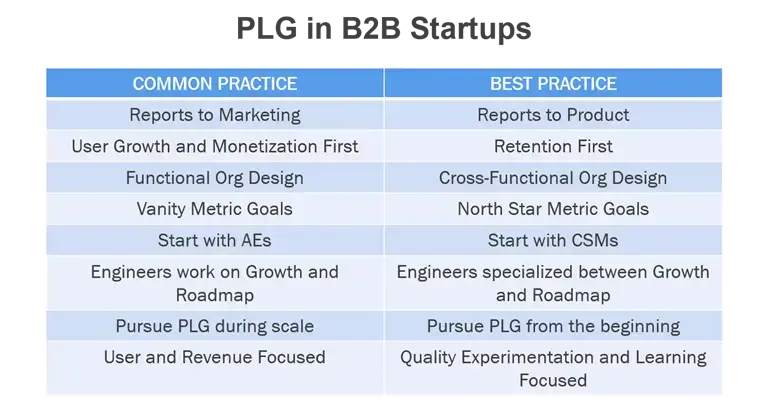
Useful materials to improve your products
Whether you’re a newbie or an experienced growth hacker, these must-read books will help you unlock the secrets of user acquisition, retention, and engagement. Think of them as power-ups in your arsenal.
Thanks! Here’s your list of must-read books on growth hacking
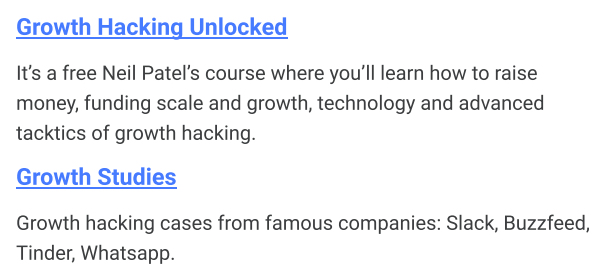
Still hesitating? Here are PLG stats to inspire you
There is a list of research and survey data that demonstrates the effectiveness of product-led growth model:
- According to OpenView, companies implementing a product-led growth strategy are three times more likely to be high-growth businesses than those not.
- A report from Totango found that companies that focus on cs — customer success (a product-led key component) have a 30% higher customer retention rate than those that don’t.
- A study published in the Harvard Business Review found that led companies achieved a 13-23% increase in valuation compared to companies with a traditional sales-led growth strategy.
- HubSpot found that led companies that use this business approach are more likely to have higher customer satisfaction rates, as they focus on providing value and solving customer problems rather than just selling products.
5 examples of companies that implemented this strategy
- Slack‘s freemium model is an excellent example of product-led growth marketing. They offer a free version of their platform, allowing users to experience the product’s core value proposition — a more straightforward way to communicate and collaborate with team members. This approach has helped Slack overgrow, attracting millions of users who have upgraded to the paid version for additional features.
- Zoom is another example of a company that uses product-led growth marketing effectively. They offer a free trial of their video conferencing platform, allowing users to try out the product’s features before sales. This strategy has helped them grow quickly, with over 400,000 customers paying for their products as of 2020.
- Dropbox’s referral program is a classic example of how product-led model can lead to explosive sales. They offer free storage space to users who invite others to use the service, incentivizing users to share the product with their network. In such a way, Dropbox has acquired tens of millions of users since its launch in 2007.
- Canva is a design platform that has used product-led growth marketing to build a loyal user base. They offer a free software version with many valuable design features that customers can try out before sales. This approach has helped them attract over 55 million customers worldwide, with many upgrading to the premium version for additional tools.
- Atlassian is a software company that leverages product-led growth to drive positive customer experinece. They offer a free trial of their software to encourage users to see products potential. This approach has helped them acquire millions of users who have then upgraded to the paid version of the software for additional features.
These companies are great examples of how product-led growth marketing can help businesses grow by offering value to users, building customer loyalty, and driving revenue growth.
If you want more examples and inspo for your business growth, subscribe to a growth marketing newsletter for a regular dose of insights
FAQ
What does PLG stand for?
PLG means product-led growth. It’s a business strategy where user acquisition and retention depend on products usage. Hence, the product becomes a driving force for the company’s sustainable and continuous development.
What are examples of product-led growth?
There’s a product-led companies list. For instance, SaaS companies like:
- Slack used user customers feedback to check if the product delivered people the promised value.
- Dropbox offered incentives to grow the end users base for further experiments and spreading software awareness worldwide.
- Dashly, a product-led company, uses free trial and PLG onboarding techniques to increase the number of users who mastered the tools and get real value from them.
- Buffer software succeeded based on the freemium (free usage) business model.
What is product-led growth vs. product growth?
- Product-led growth is a business strategy where the product is the primary tool for achieving growth. It relies on offering a product that delivers significant value to the customer, which drives adoption and loyalty.
- On the other hand, product growth is a more general term encompassing all strategies that aim to achieve growth for a product. Product-led strategies could include sales, marketing, partnerships, and other growth-related efforts beyond the product.
How to become product-led?
To successfully implement a Product-Led Growth (PLG) strategy, you must incorporate self-service to allow your product to sell itself. However, this doesn’t mean there is no room for sales since pairing self-service with modern product-led sales can enable closing more significant deals without sacrificing PLG.
- Sales representatives’ role in a PLG business needs a shift, requiring them to adopt a more strategic and consultative approach toward customer engagement while being more selective about which accounts to target.
- Investing in CS customer success is also crucial to delivering value to the end user. Customer success transcends support and aims to help users discover other use cases for your product, increasing usage across their businesses.
- Word-of-mouth marketing plays a significant role in PLG; it is free and effective in customer acquisition. However, it would help if you evolved your organization’s function.
- Successful led companies have created high-value content such as free template galleries (Notion and Airtable) and resources such as benchmark and data reports, product education materials, and product-related hubs to achieve an incredible customer acquisition rate.
Is a PLG product-led growth strategy right for your product?
We have identified five primary characteristics of successful product-led growth companies. For a product-led growth strategy to be effective, some of the following criteria must be met:
- Your software or service must offer unique value that can be personalized for the consumer, helping them perform tasks efficiently.
- PLG products must provide actual value before customers encounter the paywall, and pricing must be proportional to the value supplied as usage gradually increases.
- Your products should possess features and capabilities that enable them to function as a customer acquisition channel for new users.
- Your funnel should direct customers toward product engagement, not sales engagement.
- Led model companies should have a built-in network effect, increasing its value as more people use it in a network or company.
What are PLG metrics?
PLG metrics are key performance indicators used to measure the effectiveness and success of a product-led growth strategy. Product metrics framework typically include:
- user engagement metrics, such as product adoption rate, usage frequency, and customers retention,
- revenue metrics, such as customer lifetime value (CLTV), annual recurring revenue (ARR), and net promoter score (NPS).
They help product-led business quantify the impact of their PLG efforts and identify areas for products improvement.
How to measure product-led growth
Product-led growth business model should track and analyze key performance indicators (KPIs) for user adoption, engagement, and retention to measure product-led growth. This includes:
- product usage frequency,
- user retention,
- churn rate,
- and customer lifetime value (CLTV).
It is also essential to track revenue-related PLG KPIs such as:
- annual recurring revenue (ARR),
- profitability,
- and customer acquisition costs (CAC).
Product led growth tools
Here are some examples of PLG tools:
Read also:
- Deep dive into growth marketing analytics with Dashly experts
- 22 SaaS growth hack Facebook tactics to boost your business
- Skyrocket your company revenue with a complete guide to RevOps Revenue Operations
- B2B growth marketing: accelerating business success
- Demand Generation vs Growth Marketing: Where to focus?
- RevOps best practices: 13 tactics to implement this year
- Top 10 product led growth software your competitors use in 2023
- Growth Product Manager: Charting new frontiers in product scaling
- 20 product led growth examples to inspire your team [expert edition]




